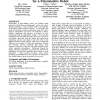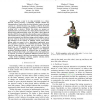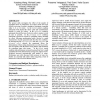267 search results - page 51 / 54 » Introduction to human-robot interaction |
HRI
2006
ACM
14 years 3 months ago
2006
ACM
Polymorphic, or shape-shifting, robots can normally tackle more types of tasks than non-polymorphic robots due to their flexible morphology. Their versatility adds to the challeng...
HRI
2010
ACM
14 years 4 months ago
2010
ACM
—When a user is in close proximity to a robot, physical contact becomes a potentially valuable channel for communication. People often use direct physical contact to guide a pers...
HRI
2009
ACM
14 years 4 months ago
2009
ACM
The present study investigates the effect of the number of controlled robots on performance of an urban search and rescue (USAR) task using a realistic simulation. Participants co...
HRI
2006
ACM
14 years 3 months ago
2006
ACM
Programming robots to carry out useful tasks is both a complex and non-trivial exercise. A simple and intuitive method to allow humans to train and shape robot behaviour is clearl...
HRI
2006
ACM
14 years 3 months ago
2006
ACM
We present a method of grounded word learning that is powerful enough to learn the meanings of first and second person pronouns. The model uses the understood words in an utteran...



